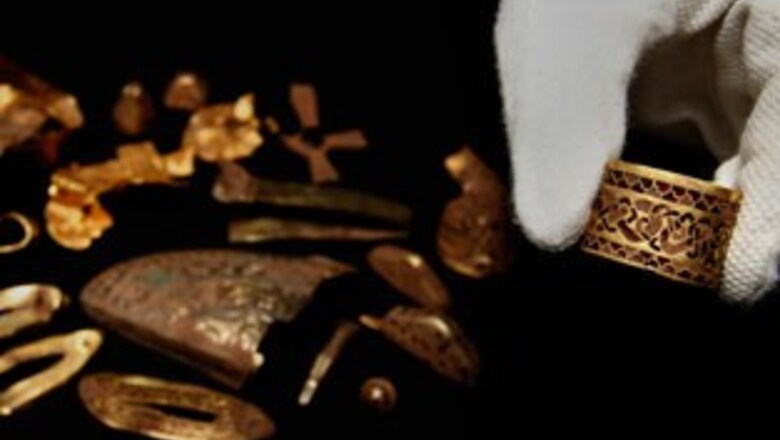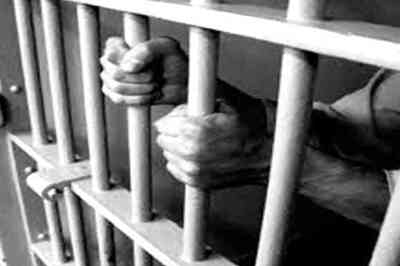
views
London: It's an unprecedented find that could revolutionise ideas about medieval England's Germanic rulers: An amateur treasure-hunter searching a farmer's field with a metal detector unearthed a huge collection of Anglo-Saxon gold and silver artifacts.
The discovery sent a thrill through Britain's archaeological community, which said on Thursday that it offers new insight into the world of the Anglo-Saxons, who ruled England from the fifth century until the 1066 Norman invasion and whose cultural influence is still felt throughout the English-speaking world.
"This is just a fantastic find completely out of the blue," Roger Bland, who managed the cache's excavation, told The Associated Press. "It will make us rethink the Dark Ages."
The treasure trove includes intricately designed helmet crests embossed with a frieze of running animals, enamel-studded sword fittings and a checkerboard piece inlaid with garnets and gold. One gold band bore a biblical inscription in Latin calling on God to drive away the bearer's enemies.
The Anglo-Saxons were a group of Germanic tribes who invaded England starting in the wake of the collapse of the Roman Empire. Their artisans made striking objects out of gold and enamel, and their language, Old English, is a precursor of modern English.
The cache of gold and silver pieces was discovered in what was once Mercia, one of five main Anglo-Saxon kingdoms, and is thought to date to between 675 and 725.
For Terry Herbert, the unemployed metal-detecting enthusiast who made the discovery on July 5 while scouring a friend's farm in the western region of Staffordshire, it was "more fun than winning the lottery."
The 55-year-old spent five days searching the field alone before he realized he needed help and notified authorities. Professional archaeologists then took over the find.
"I was going to bed and in my sleep I was seeing gold items," Herbert said of the experience.
The gold alone in the collection weighs 11 pounds and suggests that early medieval England was a far wealthier place than previously believed, according to Leslie Webster, the former curator of Anglo-Saxon archaeology at the British Museum.
She said the crosses and other religious artifacts mixed in with the military items might shed new light on the relationship between Christianity and warfare among the Anglo-Saxons — in particular a large cross she said may have been carried into battle.
The hoard was officially declared treasure by a coroner on Thursday, which means it will be valued by experts and offered up for sale to a museum in Britain. Proceeds will be split 50-50 between Herbert and his farmer friend, who has not been identified. The find's exact location is being kept secret to deter looters.
Bland said he could not give a precise figure for the value of the collection, but said the two could each be in line for a "seven-figure sum."
Kevin Leahy, the archaeologist who catalogued the find, said the stash includes dozens of pommel caps — decorative elements attached to the knobs of swords — and appeared to be war loot. He noted that "Beowulf," the Anglo-Saxon epic poem, contains a reference to warriors stripping the pommels of their enemies' weapons as mementoes.
"It looks like a collection of trophies, but it is impossible to say if the hoard was the spoils from a single battle or a long and highly successful military career," he said.
"We also cannot say who the original, or the final, owners were, who took it from them, why they buried it or when? It will be debated for decades."
Experts said they've so far examined a total of 1,345 items. But they've also recovered 56 pieces of earth that X-ray analysis suggests contain more artifacts — meaning the total could rise to about 1,500.
The craftsmanship was some of the highest-quality ever seen in finds of this kind, Leahy said, and many British archaeologists clearly shared his enthusiasm.
Bland, who has documented discoveries across Britain, called it "completely unique." Martin Welch, a specialist in Anglo-Saxon archaeology at University College London, said no one had found "anything like this in this country before."
Herbert said one expert likened his discovery to finding Egyptian Pharoah Tutankhamen's tomb, adding: "I just flushed all over when he said that. The hairs on the back of my neck stood up."
The collection is in storage at the Birmingham Museum and Art Gallery, where some of the items are to go on display starting Friday.
It's unclear how the gold ended up in the field, although archaeologists suggested it may have been buried to hide the loot from roving enemies, a common practice at the time. The site's location is unusual as well — Anglo-Saxon remains have tended to cluster in the country's south and east, while the so-called "Staffordshire hoard" was found in the west.
In the meantime, archaeologists say they're likely to be busy for years puzzling out the meaning of some of the collection's more unusual pieces — like five enigmatic gold snakes or a strip of gold bearing a crudely written and misspelt Biblical inscription in Latin.
"Rise up, O Lord, and may thy enemies be dispersed and those who hate thee be driven from thy face," reads the inscription, believed to be from the Book of Numbers.
Also of interest is the largest of the crosses, which experts say may have been an altar or processional piece. It had been folded, possibly to make it fit into a small space prior to burial, and the apparent lack of respect shown to such a Christian symbol may point to the hoard being buried by pagans.
"The things that we can't identify are the ones that are going to teach us something new," Leahy said.
For England, a country at the edge of Europe whose history owes an enormous debt to the Anglo-Saxons, the find has the potential to become one of its top national treasures, according to Webster.
Caroline Barton, assistant treasure registrar at the British Museum, said objects over 300 years old and made up of more that 10 percent precious metal are only offered for sale to accredited museums in Britain, so the collection will not be leaving the country.

















Comments
0 comment